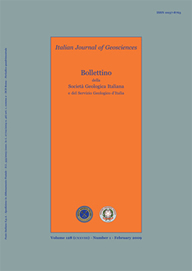
The exposure of urban areas to surface faulting hazard in Italy: a quantitative analysis
L. Guerrier(*), A.M. Blumetti, P. Di Manna, L. Serva & E. Vittori
(*) Geological Survey of Italy, Italian Agency for Environment Protection and for Technical Services (APAT), Via Curtatone, 3 -001
Volume: 128 (2009) f.1
Pages: 179-189
Abstract
Surface faulting commonly associated to moderate to strong earthquakes is an important source of hazard determining often a substantial risk where urban areas, including industries and lifelines, are developed. However, the assessment of seismic hazard is generally based on the vibratory ground motion whereas the surface effects produced by the reactivation of the seismogenic structure are often disregarded. This issue is particularly important in Italy, as its territory is affected by a great number of capable faults (i.e., faults able to produce significant ruptures or deformations at or near the topographic surface in the near future).
This paper aims at evaluating indices able to quantify the level of exposure of urban areas to surface faulting hazard in Italy, and to show where the interaction between capable faults and urbanization is more critical.
The analysis was conducted for each of the ZS9 seismogenic zones of the Italian territory through the intersection of capable faults, from the ITHACA database, and urbanized areas, from the CORINE Land Cover database. The results of spatial analyses have been weighted with a coefficient of surface faulting to take into account the maximum expected displacement for each zone.
In all the ZS9 zones where data input have been considered reliable for this analysis, it is shown that about 4,4% of the territory is prone to surface faulting hazard and about 7,3 % of these areas is currently urbanized. This result is an underestimate due to some lack of information in data input, either in the distribution of capable faults and in some types of lifelines.
Beyond the uncertainties in the numerical values of surface faulting indices due to input data quality, the analysis has pointed out the most critical areas (Eastern Sicily and Tyrrhenian Calabria followed by Friuli and the inner sector of Central-Southern Apennines) both in terms of surface faulting hazard and exposure of urban areas. Densely urbanized areas, such as the margins of the Po plain, although affected by several capable faults, are less critical due to the minimum potential for effective surface displacement. Moreover, it is notable that indices of surface faulting evaluated in two sample zones out of the ZS9 zonation have shown that the phenomenon is comparable with the adjacent zone.
In general, this study has highlighted the necessity of limiting urban expansion where surface faulting hazard is more critical. This issue requires specific regulating measures in regional planning.
Keywords
Get Full Text